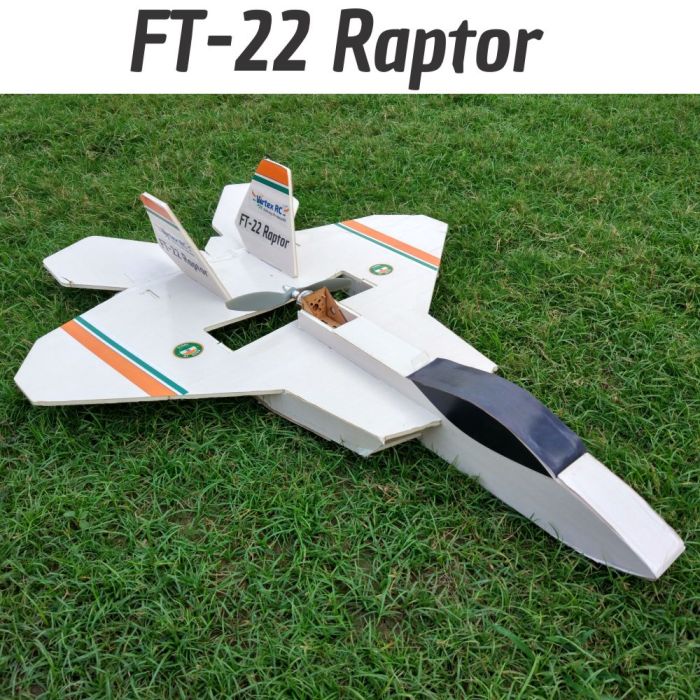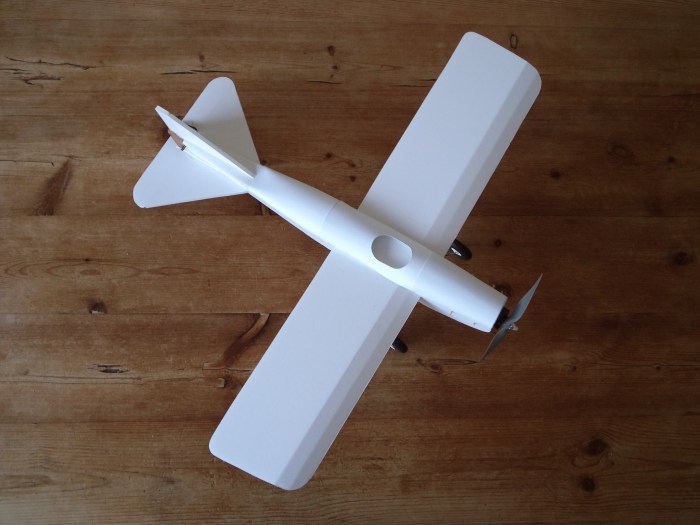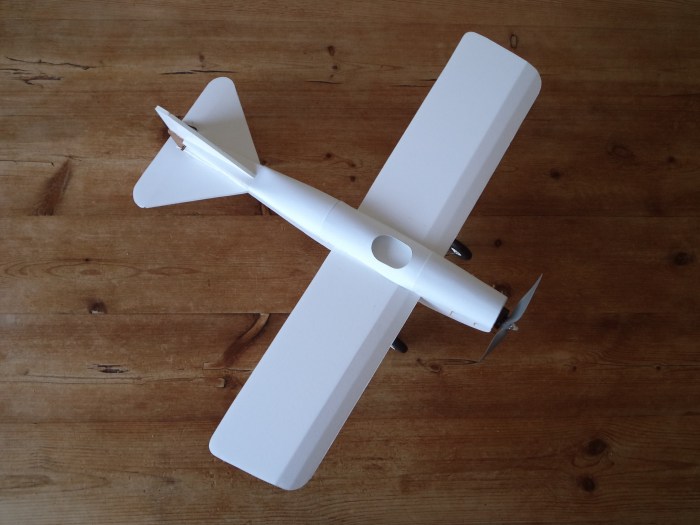DIY RC Plane: Building your own remote-controlled airplane is a rewarding experience that blends engineering, creativity, and the thrill of flight. From the initial design to the exhilarating first flight, the journey of crafting a DIY RC plane is a testament to human ingenuity and the timeless fascination with aviation.
This comprehensive guide will walk you through the entire process, from selecting materials and designing your aircraft to mastering the art of flight. Whether you’re a seasoned hobbyist or a curious beginner, this guide provides the knowledge and insights needed to embark on your own DIY RC plane adventure.
Introduction to DIY RC Planes
Building your own RC plane is a rewarding and exciting hobby that combines technical skills, creativity, and the thrill of flight. DIY RC planes offer a unique experience that goes beyond simply flying a ready-made model.
The appeal of DIY RC planes lies in the satisfaction of creating something from scratch and the ability to customize your aircraft to meet your specific needs and preferences. Whether you’re a seasoned pilot or a complete beginner, building your own RC plane can be a fun and challenging endeavor.
Benefits of Building Your Own RC Plane
Building your own RC plane offers several advantages over purchasing a ready-made model. These include:
- Customization: You have complete control over the design, materials, and features of your aircraft, allowing you to create a plane that perfectly suits your flying style and preferences.
- Learning Experience: Building an RC plane provides valuable hands-on experience with aerodynamics, electronics, and construction techniques. You’ll gain a deeper understanding of how aircraft work and how to troubleshoot problems.
- Cost Savings: While the initial investment in tools and materials might seem high, building your own RC plane can be more cost-effective in the long run, especially if you plan to build multiple models or make modifications.
- Sense of Accomplishment: The satisfaction of successfully building and flying your own RC plane is unparalleled. You’ll have a sense of pride and accomplishment knowing that you created something from scratch.
History of RC Planes
The history of RC planes dates back to the early 20th century, with the first successful radio-controlled aircraft being developed in the 1930s. Early RC planes were primarily used for military purposes, such as target practice and reconnaissance.
- Early Development: The first radio-controlled aircraft were bulky and unreliable, often using bulky vacuum tubes and limited battery technology. These early models were primarily used for military purposes, such as target practice and reconnaissance.
- Post-World War II: After World War II, advancements in electronics and materials led to the development of smaller, more powerful, and reliable RC planes. The hobby began to gain popularity, with enthusiasts building and flying their own models.
- Modern Era: Today, RC planes are more sophisticated than ever before, featuring advanced electronics, lightweight materials, and powerful motors. The hobby continues to grow, with a wide range of models available for all levels of experience.
Choosing the Right Materials

Building an RC plane involves selecting the right materials that meet your project requirements and skill level. The choice of materials impacts the plane’s performance, durability, and overall build process. Let’s delve into some common materials used in DIY RC plane construction and their respective advantages and disadvantages.
Balsa Wood
Balsa wood is a lightweight and strong material commonly used in RC plane construction. It’s easy to work with, allowing for intricate designs and modifications.
- Advantages: Lightweight, strong, easy to work with, readily available, relatively inexpensive.
- Disadvantages: Fragile, susceptible to moisture damage, requires careful handling.
Balsa wood is an excellent choice for beginners due to its affordability and ease of use. However, it’s crucial to handle it carefully to prevent breakage.
Foam
Foam is another popular material for RC plane construction, offering a balance of strength and flexibility. It’s readily available in various densities and thicknesses, making it suitable for different plane designs.
- Advantages: Lightweight, durable, resilient to impacts, easy to shape and cut, readily available, affordable.
- Disadvantages: Less strong than balsa wood, may be susceptible to heat damage, limited design options compared to balsa wood.
Foam is an excellent option for beginners and experienced builders alike, offering a balance of durability and ease of use.
Fiberglass
Fiberglass is a strong and durable material often used for high-performance RC planes. It’s typically used as a reinforcement layer over a balsa wood or foam core, providing increased strength and rigidity.
- Advantages: Strong, durable, water-resistant, can withstand high stresses, excellent for high-performance planes.
- Disadvantages: More complex to work with, requires specialized tools and techniques, heavier than balsa wood or foam, can be expensive.
Fiberglass is suitable for experienced builders looking to build high-performance planes. Its strength and durability make it ideal for demanding flight conditions.
Selecting Materials Based on Plane Type and Skill Level
Choosing the right material depends on the type of plane you’re building and your skill level.
- Beginners: Balsa wood or foam are excellent choices for beginners due to their ease of use and affordability. They provide a forgiving learning experience, allowing you to experiment and learn the basics of RC plane construction.
- Intermediate: Intermediate builders can explore more advanced materials like fiberglass or carbon fiber. These materials offer increased strength and performance but require more experience and specialized tools.
- Advanced: Advanced builders can utilize a combination of materials, including balsa wood, foam, fiberglass, and carbon fiber, to create highly customized and high-performance planes.
Ultimately, the choice of material comes down to your individual preferences, project requirements, and skill level. Experiment with different materials to find what works best for you and your building style.
Building the Airframe
The airframe is the backbone of your RC plane, providing the structure and shape that allows it to fly. A well-designed airframe is lightweight, strong, and aerodynamic, which are crucial for a successful flight. This section will guide you through the process of building your own airframe, covering everything from choosing the right materials to assembling the components.
Cutting and Shaping Materials
The first step in building the airframe is to cut and shape the materials according to your design. You’ll likely be working with lightweight materials like balsa wood, foam board, or carbon fiber.
- Balsa wood is a popular choice for its strength-to-weight ratio and ease of working with. You can cut it with a sharp knife or a saw, and shape it with sandpaper or a sanding block.
- Foam board is another lightweight and affordable option. It’s easy to cut with a craft knife and can be shaped with a heat gun.
- Carbon fiber is a very strong and lightweight material, but it’s more expensive and requires specialized tools to work with. It’s often used for structural components like spars and wing ribs.
Joining Materials
Once you’ve cut and shaped your materials, you need to join them together to form the airframe. There are a few different methods you can use, each with its own advantages and disadvantages.
- Hot glue is a quick and easy way to join materials, but it’s not as strong as other methods. It’s best used for temporary or non-structural joints.
- Epoxy is a stronger adhesive that provides a more permanent bond. It’s ideal for structural joints, but it takes longer to cure.
- Wood glue is another good option for joining wood components. It’s strong and durable, but it can be messy.
Sanding and Finishing
After joining the materials, you’ll need to sand the airframe to create a smooth and aerodynamic surface. This is important for reducing drag and improving flight performance.
- Use sandpaper of different grits to smooth out any rough edges and imperfections.
- Pay attention to the leading edge of the wings and the tail surfaces, as these areas are particularly important for aerodynamics.
Tips for a Strong and Lightweight Airframe
Here are a few tips for building a strong and lightweight airframe:
- Use lightweight materials. Balsa wood, foam board, and carbon fiber are all excellent choices for RC plane airframes.
- Minimize the amount of material used. Avoid using more material than necessary, as this will add weight to the airframe.
- Use strong joints. Epoxy and wood glue are good choices for structural joints.
- Avoid unnecessary weight. Don’t add unnecessary weight to the airframe by using heavy hardware or components.
- Balance the airframe. Ensure the airframe is balanced properly to prevent it from tipping or nosediving during flight.
Remember, a well-designed and built airframe is essential for a successful RC plane. Take your time, follow the instructions carefully, and don’t be afraid to experiment!
First Flight and Tuning
The moment of truth has arrived! After all the hard work and meticulous construction, it’s time to take your DIY RC plane to the skies. However, before you launch it into the air, a few crucial steps need to be taken to ensure a safe and successful maiden flight.
Pre-Flight Preparations
Before venturing out to the flying field, it’s essential to perform a thorough pre-flight inspection. This includes balancing the plane, checking control response, and selecting a suitable location.
- Balancing: A well-balanced plane will fly straight and level. You can achieve this by adjusting the position of the battery or adding weight to the tail. The goal is to have the center of gravity (CG) at the recommended location specified by the plane’s design. To find the CG, balance the plane on a finger or a thin edge. The plane should balance perfectly at the CG point.
- Control Response: With the plane powered on, test the control surfaces (ailerons, elevator, and rudder) to ensure they respond smoothly and without any binding or glitches. You can do this by gently moving the control sticks on your transmitter and observing the corresponding movements of the control surfaces.
- Location: The first flight should take place in a calm, open area with minimal wind. A grassy field or a park with no obstacles is ideal. Avoid flying near trees, power lines, or other hazards.
First Flight and Initial Adjustments, Diy rc plane
The first flight should be short and cautious. Start by gently applying throttle and allowing the plane to gain altitude. Observe its behavior and make any necessary adjustments.
- Trim Adjustments: Trim adjustments are used to fine-tune the plane’s flight characteristics. For instance, if the plane tends to drift to the left, you can adjust the aileron trim to compensate. The trim settings can be accessed on your transmitter.
- Tuning for Optimal Performance: Once the plane is flying smoothly, you can start experimenting with different settings to achieve optimal performance. This may involve adjusting the control throws, expo settings, or even the CG location.
Importance of Calm Wind
A calm wind environment is crucial for the first flight. Wind gusts can make it difficult to control the plane, especially for a beginner. A gentle breeze is acceptable, but strong winds can cause the plane to become unstable and difficult to manage.
Advanced Techniques and Modifications: Diy Rc Plane

Once you’ve mastered the basics of building and flying your RC plane, you can explore the exciting world of advanced techniques and modifications. These enhancements can dramatically improve your plane’s performance and aesthetics, allowing you to perform impressive maneuvers and customize your aircraft to your liking.
Aerobatics
Aerobatics is the art of performing complex maneuvers with an aircraft, showcasing its agility and control. Common aerobatic maneuvers include:
- Loops: A complete circle flown in the vertical plane.
- Rolls: A 360-degree rotation around the aircraft’s longitudinal axis.
- Immelmann Turn: A half-loop followed by a half-roll.
- Cuban Eight: A figure-eight pattern flown in the vertical plane.
- Inverted Flight: Flying upside down.
Mastering aerobatics requires practice and skill. It’s crucial to understand the principles of flight and how your plane responds to control inputs. You’ll need to learn how to control the plane’s attitude and direction, particularly when flying upside down or at high speeds.
Advanced Flying Techniques
Beyond aerobatics, there are other advanced flying techniques that can enhance your flying experience and challenge your skills:
- Precision Landing: Landing your plane accurately on a specific target, such as a runway or a designated area.
- Formation Flying: Flying multiple planes in a coordinated group, requiring precise timing and communication.
- Low-Level Flight: Flying close to the ground, demanding excellent control and situational awareness.
- Long-Distance Flying: Flying your plane for extended distances, requiring careful planning and efficient battery management.
These techniques require practice, patience, and a thorough understanding of your plane’s capabilities and limitations. It’s essential to start with basic maneuvers and gradually work your way up to more challenging techniques.
Common Modifications
Modifying your RC plane can improve its performance, aesthetics, and overall flying experience. Here are some common modifications:
- Wing Modifications: Changing the wingspan, dihedral, or airfoil can affect stability, maneuverability, and speed.
- Power System Upgrades: Upgrading the motor, ESC, or battery can provide more power and flight time.
- Control Surface Adjustments: Modifying the size or shape of control surfaces like ailerons, elevators, and rudders can enhance responsiveness and control.
- Landing Gear Modifications: Changing the type or size of landing gear can improve stability during takeoff and landing.
- Aesthetics: Adding custom paint schemes, decals, or lights can personalize your plane and make it stand out.
Before making any modifications, it’s essential to research and understand the potential impact on your plane’s performance and flight characteristics. It’s also a good idea to consult with experienced RC pilots or online forums for advice and guidance.
Resources for Advanced Modifications
There are numerous resources available for learning about and experimenting with advanced RC plane modifications:
- Online Forums: Forums like RC Groups and RCGroups provide a platform for sharing knowledge, discussing modifications, and seeking advice from experienced pilots.
- YouTube Channels: Numerous YouTube channels dedicated to RC planes offer tutorials, reviews, and insights into advanced techniques and modifications.
- Books and Magazines: Specialized books and magazines on RC planes cover various topics, including building, flying, and modifying aircraft.
- RC Clubs: Joining an RC club provides access to experienced pilots, workshops, and flying fields where you can learn and share your passion.
These resources can provide valuable information, inspiration, and support as you explore the world of advanced RC plane modifications.
Safety and Maintenance
Flying RC planes is an enjoyable hobby, but it’s crucial to prioritize safety. Operating RC planes responsibly ensures a safe and enjoyable experience for you and those around you. Regular maintenance is essential for keeping your RC plane in top condition, preventing potential issues and ensuring a longer lifespan.
Safety Guidelines
It is important to prioritize safety when operating RC planes. Flying responsibly ensures a safe and enjoyable experience for you and others.
- Fly in designated areas: Choose a spacious, open area away from people, buildings, and obstacles. Avoid flying near airports, power lines, or other restricted airspace.
- Check weather conditions: Wind, rain, and other weather conditions can affect your RC plane’s flight. Only fly in calm, clear weather conditions.
- Maintain a safe distance: Keep your RC plane at a safe distance from other people, especially children.
- Use caution around wildlife: Be aware of your surroundings and avoid flying near wildlife.
- Wear safety glasses: Always wear safety glasses to protect your eyes from debris or unexpected events.
- Use common sense: Be aware of your surroundings and use common sense when operating your RC plane.
Maintenance Procedures
Routine maintenance ensures your RC plane operates smoothly and safely. Regular inspections and repairs can prevent issues and extend the life of your aircraft.
- Inspect the airframe: Regularly inspect the airframe for cracks, damage, or loose components.
- Check the control surfaces: Ensure the control surfaces (ailerons, elevator, rudder) are free of damage and move smoothly.
- Inspect the motor and ESC: Look for signs of wear or damage on the motor and electronic speed controller (ESC).
- Check the battery: Ensure the battery is in good condition and has adequate charge.
- Inspect the receiver and transmitter: Verify the receiver and transmitter are functioning correctly.
- Lubricate moving parts: Regularly lubricate moving parts, such as control horns and linkages, to prevent wear and tear.
- Clean the aircraft: Regularly clean the aircraft to remove dirt, dust, and debris.
Troubleshooting
If you experience problems with your RC plane, it is important to troubleshoot the issue systematically.
- Check the battery: Ensure the battery is fully charged and in good condition.
- Inspect the motor and ESC: Verify the motor and ESC are functioning correctly.
- Check the receiver and transmitter: Ensure the receiver and transmitter are properly connected and functioning.
- Inspect the control surfaces: Verify the control surfaces are free of damage and moving smoothly.
- Examine the airframe: Check for any cracks, damage, or loose components.
The world of DIY RC planes is a vast and exciting realm, offering endless possibilities for creativity, innovation, and flight. As you delve into the world of building your own aircraft, remember that the journey is just as rewarding as the destination. Embrace the challenges, celebrate the successes, and enjoy the thrill of soaring through the skies with your own handcrafted creation.
Building a DIY RC plane can be a rewarding project, combining technical skills with a love for flight. While you’re working on your plane, you might also consider upgrading your workshop with a new air conditioner. Check out MrCool DIY mini splits for a convenient and efficient way to cool down your workspace, ensuring you stay comfortable while building your RC plane.

